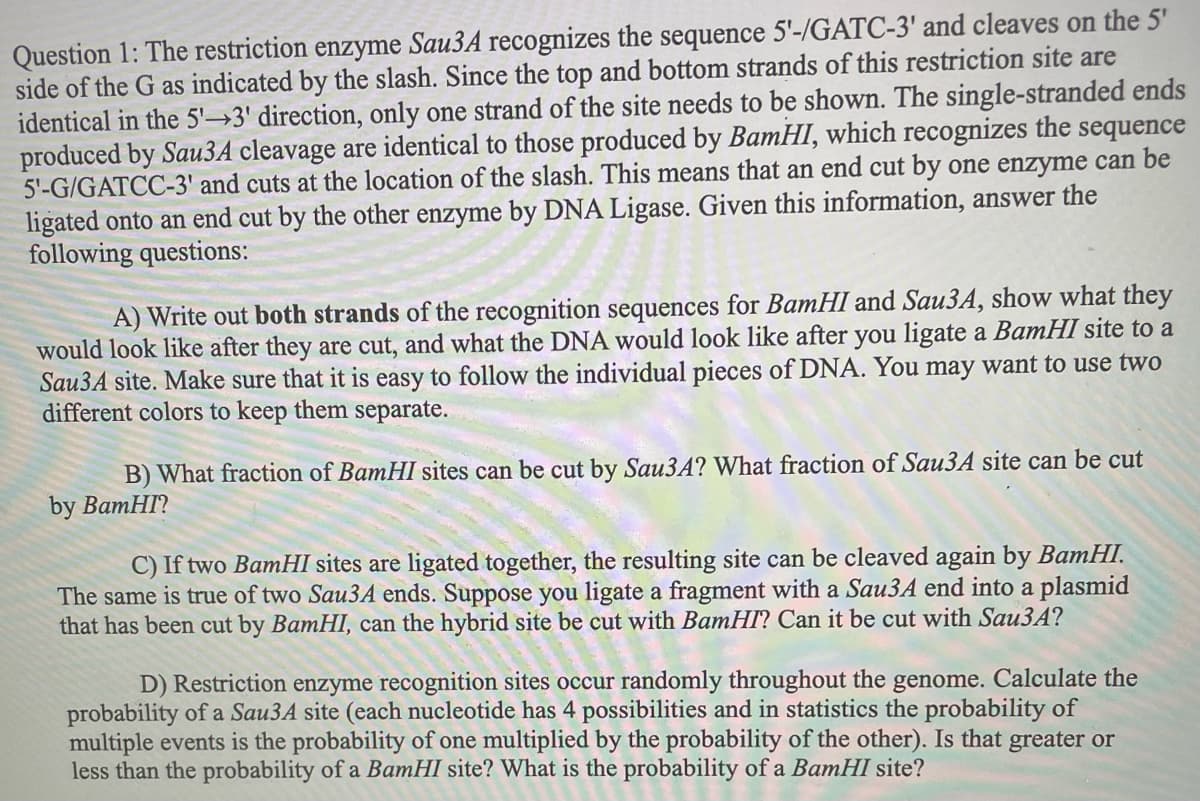A) Write out both strands of the recognition sequences for BamHI and Sau3A, show what they would look like after they are cut, and what the DNA would look like after you ligate a BamHI site to a Sau3A site. Make sure that it is easy to follow the individual pieces of DNA. You may want to use two different colors to keep them separate. B) What fraction of BamHI sites can be cut by Sau3A? What fraction of Sau3A site can be cut by BamHI? C) If two BamHI sites are ligated together, the resulting site can be cleaved again by BamHI. The same is true of two Sau3A ends. Suppose you ligate a fragment with a Sau3A end into a plasmid that has been cut by BamHI, can the hybrid site be cut with BamHI? Can it be cut with Sau3A? D) Restriction enzyme recognition sites occur randomly throughout the genome. Calculate the probability of a Sau3A site (each nucleotide has 4 possibilities and in statistics the probability of multiple events is the probability of one multiplied by the probability of the other). Is that greater or less than the probability of a BamHI site? What is the probability of a BamHI site?
A) Write out both strands of the recognition sequences for BamHI and Sau3A, show what they would look like after they are cut, and what the DNA would look like after you ligate a BamHI site to a Sau3A site. Make sure that it is easy to follow the individual pieces of DNA. You may want to use two different colors to keep them separate. B) What fraction of BamHI sites can be cut by Sau3A? What fraction of Sau3A site can be cut by BamHI? C) If two BamHI sites are ligated together, the resulting site can be cleaved again by BamHI. The same is true of two Sau3A ends. Suppose you ligate a fragment with a Sau3A end into a plasmid that has been cut by BamHI, can the hybrid site be cut with BamHI? Can it be cut with Sau3A? D) Restriction enzyme recognition sites occur randomly throughout the genome. Calculate the probability of a Sau3A site (each nucleotide has 4 possibilities and in statistics the probability of multiple events is the probability of one multiplied by the probability of the other). Is that greater or less than the probability of a BamHI site? What is the probability of a BamHI site?
Biochemistry
9th Edition
ISBN:9781319114671
Author:Lubert Stryer, Jeremy M. Berg, John L. Tymoczko, Gregory J. Gatto Jr.
Publisher:Lubert Stryer, Jeremy M. Berg, John L. Tymoczko, Gregory J. Gatto Jr.
Chapter1: Biochemistry: An Evolving Science
Section: Chapter Questions
Problem 1P
Related questions
Question

Transcribed Image Text:Question 1: The restriction enzyme Sau3A recognizes the sequence 5'-/GATC-3' and cleaves on the 5'
side of the G as indicated by the slash. Since the top and bottom strands of this restriction site are
identical in the 5'-3' direction, only one strand of the site needs to be shown. The single-stranded ends
produced by Sau3A cleavage are identical to those produced by BamHI, which recognizes the sequence
5'-G/GATCC-3' and cuts at the location of the slash. This means that an end cut by one enzyme can be
ligated onto an end cut by the other enzyme by DNA Ligase. Given this information, answer the
following questions:
A) Write out both strands of the recognition sequences for BamHI and Sau3A, show what they
would look like after they are cut, and what the DNA would look like after you ligate a BamHI site to a
Sau3A site. Make sure that it is easy to follow the individual pieces of DNA. You may want to use two
different colors to keep them separate.
B) What fraction of BamHI sites can be cut by Sau3A? What fraction of Sau3A site can be cut
by BamHI?
C) If two BamHI sites are ligated together, the resulting site can be cleaved again by BamHI.
The same is true of two Sau3A ends. Suppose you ligate a fragment with a Sau3A end into a plasmid
that has been cut by BamHI, can the hybrid site be cut with BamHI? Can it be cut with Sau3A?
D) Restriction enzyme recognition sites occur randomly throughout the genome. Calculate the
probability of a Sau3A site (each nucleotide has 4 possibilities and in statistics the probability of
multiple events is the probability of one multiplied by the probability of the other). Is that greater or
less than the probability of a BamHI site? What is the probability of a BamHI site?
Expert Solution
This question has been solved!
Explore an expertly crafted, step-by-step solution for a thorough understanding of key concepts.
This is a popular solution!
Trending now
This is a popular solution!
Step by step
Solved in 3 steps with 3 images

Recommended textbooks for you

Biochemistry
Biochemistry
ISBN:
9781319114671
Author:
Lubert Stryer, Jeremy M. Berg, John L. Tymoczko, Gregory J. Gatto Jr.
Publisher:
W. H. Freeman

Lehninger Principles of Biochemistry
Biochemistry
ISBN:
9781464126116
Author:
David L. Nelson, Michael M. Cox
Publisher:
W. H. Freeman

Fundamentals of Biochemistry: Life at the Molecul…
Biochemistry
ISBN:
9781118918401
Author:
Donald Voet, Judith G. Voet, Charlotte W. Pratt
Publisher:
WILEY

Biochemistry
Biochemistry
ISBN:
9781319114671
Author:
Lubert Stryer, Jeremy M. Berg, John L. Tymoczko, Gregory J. Gatto Jr.
Publisher:
W. H. Freeman

Lehninger Principles of Biochemistry
Biochemistry
ISBN:
9781464126116
Author:
David L. Nelson, Michael M. Cox
Publisher:
W. H. Freeman

Fundamentals of Biochemistry: Life at the Molecul…
Biochemistry
ISBN:
9781118918401
Author:
Donald Voet, Judith G. Voet, Charlotte W. Pratt
Publisher:
WILEY

Biochemistry
Biochemistry
ISBN:
9781305961135
Author:
Mary K. Campbell, Shawn O. Farrell, Owen M. McDougal
Publisher:
Cengage Learning

Biochemistry
Biochemistry
ISBN:
9781305577206
Author:
Reginald H. Garrett, Charles M. Grisham
Publisher:
Cengage Learning

Fundamentals of General, Organic, and Biological …
Biochemistry
ISBN:
9780134015187
Author:
John E. McMurry, David S. Ballantine, Carl A. Hoeger, Virginia E. Peterson
Publisher:
PEARSON